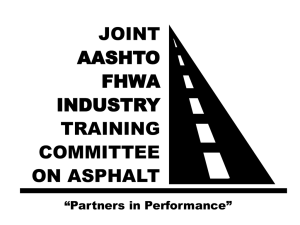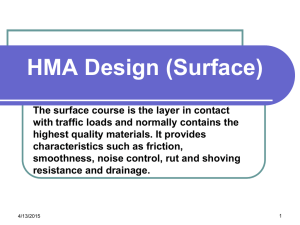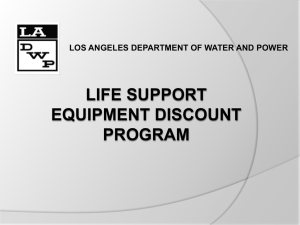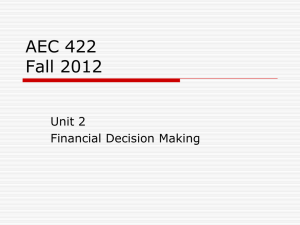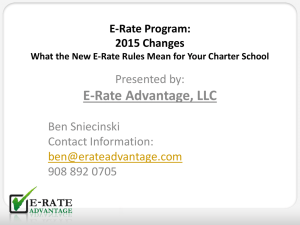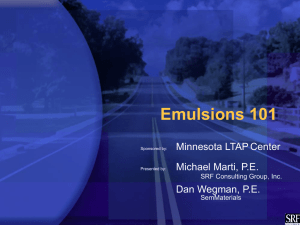Life Cycle Cost Definitions - Asphalt Pavement Association of Indiana
advertisement
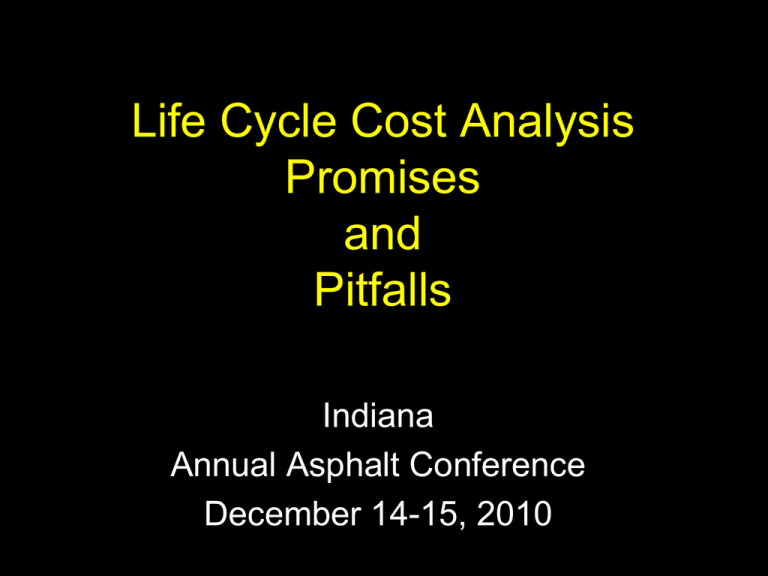
Life Cycle Cost Analysis Promises and Pitfalls Indiana Annual Asphalt Conference December 14-15, 2010 Acknowledgements David Timm, Auburn University Carlos Rosenberger, Asphalt Institute Field Engineer, Dillsburg, PA What is LCCA? “A process for evaluating the total economic worth of a useable project segment by analyzing initial costs and discounted future costs, such as maintenance, reconstruction, rehabilitation, restoring, and resurfacing costs, over the life of the project segment. ” TEA 21 (98) How is it used? • To make Go/No Go decisions concerning projects. • To evaluate economic impacts of engineering decisions. • To select the most economical choice among alternatives. • To drive competition in initial bids. – Alt. A – lower initial, higher rehab costs – Alt. B – higher initial, lower rehab costs (Alt. A)initial bid + (Alt. A – Alt. B)rehab costs • Objective, defensible, understandable. How is it done? • Net Present Value (NPV) – FHWA recommendation – APA method – Requires equal analysis period • Equivalent Uniform Annual Cost or Worth (EUAC or EUAW) – ACPA recommendation – Does not require equal life, BUT – Does require analysis being extended to common multiple FHWA Approach • Use Net Present Value method of costing – Sum of initial cost and discounted future costs • Use Real Discount Rate – Difference between interest and inflation • Use of User Cost as Separate Consideration LCCA Policy Statement (9/96) • FHWA Philosophy ... – Decision support tool – Results are not decisions – Use process to improve maintenance and rehabilitation strategies – Logical evaluation process is as important as results Policy Statement Con’t ... – Agency and user costs should be included – Future costs should be discounted to their net present value (NPV) LCCA Policy Statement (9/96) • LCCA important consideration in all highway investment decisions • Level of detail commensurate with level of investment • Long analysis periods – Pavements - min. 35 years – Bridges - min. 75 years Life Cycle Cost Components 1 NPV I .C. R.C.k nk k 1 1 i N Initial Construction Discount Rate Cost Year of Activity Rehabilitation Maintenance Time Salvage Life Cycle Cost – Net Present Value Cost Net Present Value Time Carlos Rosenberger “Thou shall not use a strategy that cannot actually occur!” Examples: • No or very little rehabilitation • Unrealistically close rehabilitation intervals • Unrealistically frequent maintenance • Unrealistically thick pavements at end of analysis Tricks of the Trade Associations • They say - Equivalent Uniform Annual Cost allows comparison of options of “unequal lives”. • The wrong way: – NPV of each alternate over each of their “lives” and annualize the amount. – Shorter “lives” and more frequent maintenance will have higher EUAC. • The right way: – NPV of each alternative out to a common year multiplier and annualize the amount. – Repeatedly do the same strategy. As for Asphalt Being “Short Lived” 1000 Lane Miles 800 HMA (Lane Miles) WSDOT Interstate Ages PCCP (Lane Miles) 600 400 200 0 0 - 10 11 - 20 21 - 30 31 - 40 Age (Years) 41 - 50 51 - 60 61 or More Other Sources of Information • Kansas (Cross) Study – Asphalt pavements last as long as concrete, but much cheaper • Ohio Interstate Study – Long life asphalt with low maintenance • Minnesota – ½ of PCC overlaid before year 20 – ½ of remaining PCC had major repairs – 1st resurfacing for asphalt ~18 years – Asphalt pavements > 60 years old Initial Cost • Usually accounts for 70% or so of LCC • Materials – Unit prices and quantities • Labor – Daily/hourly rates • May be part of material unit prices • Traffic Control – Daily/hourly costs • Only consider mutually exclusive costs General Conditions • • • • • • • • Four lanes (2 way) 40-year Analysis 4% Discount Rate Level Terrain Rural Area 25000 ADT 15% Trucks 2% Growth Work Zone Speed Limit 40 mph HMA • Pavement Section – Perpetual 2” Wearing Course - $60/ton 4” Intermediate - $55/ton 6” HMA Base - $50/ton 6” Granular Base - $20/ton • Rehabilitation – 2” mill & fill at various times. PCC • Pavement Section: 12” PCC – JPCP @ $50/sy 6” Granular Base - $20/ton • Rehabilitation: • Grinding at year 18 with 5% patching. • 4” Overlay at year 30 with 5% patching. Sensitivity Analysis • Rehabilitation Interval – 10-year – 15-year – 20-year • Discount Rate – Vary between 1 and 8 percent • User Costs – 24-hr lane closure for both – 10-hr night lane closure for HMA Rehabilitation Interval ~80% FHWA - Data from LTPP Study Data from GPS-6 (FHWA-RD-00-165) Conclusions Thicker overlays mean less: Fatigue Cracking Transverse Cracking Longitudinal Cracking Most AC Overlays > 15 years before Rehab Many AC Overlays > 20 years before Significant Distress Need Credit for: • Superpave – Improved performance, but higher costs • Premium Surface Materials – Polymers for high traffic and climate considerations – SMA – Improved performance • OGFC – Usually requires more frequent resurfacing, BUT. . . – It is an elective safety improvement and – It saves lives! How Do Best Paving Practices Affect Life-Cycle Costs? Considerably! Construction-Related Best Practices Design and Materials-Related Best Practices Diamond Paving Commendation • • • • Paving crew recognition Training of supervisors and crews Paving procedures Compliance Diamond Paving Commendation - Goals • Quality asphalt pavement thru training • Increase competitive advantage over other construction products • Give customers added assurance of quality • Reward top tier contractors • Provides a blue print for excellence Diamond Paving Commendation • • • • • • Quality control Work zone safety practices Site preparation and planning Paver operation Compaction Training Diamond Paving Commendation • Who can apply? • Anyone with a paving company! • How can I apply? • Go to www.hotmix.org • Bound to be expensive! • $350 per year – early application • $400 – normal application Effect of Best Practices Good Practices – 15 Years Less Than Good – 10 Years Best Practices – 20 Years $ 50 years Discount Rate • Used in NPV equation to bring future costs to present value • FHWA recommends using real discount rate – Does not include inflation • Future cost estimates should not include inflation • FHWA recommends 4% discount rate – Most state DOT’s used values between 3 and 5% in 1996 Real Discount Rate 8.06% Yield on a 10-year Treasury note 6.94% Amount Lost Amount Lost to Inflation to Inflation 3.74% 3.21% Mar. 91 1992 1993 1994 1995 1996 Aug ‘96 Real Discount Rates Source: OMB Circular A-94 YEAR Nov 92 Feb 93 Feb 94 Feb 95 Feb 96 Feb 97 Jan 98 Avg Std Investment Maturity 3 5 7 10 2.7 3.1 3.3 3.6 3.1 3.6 4.0 4.3 2.1 2.3 2.5 2.7 4.2 4.5 4.6 4.8 2.7 2.7 2.8 2.8 3.2 3.3 3.4 3.5 3.4 3.5 3.5 3.6 3.1 3.3 3.4 3.6 0.6 0.7 0.7 0.7 30 3.8 4.5 2.8 4.9 3.0 3.6 3.8 3.8 0.7 (No Inflation Premium) Present Value Factors Year 0 1 2 3 4 5 4.0% 1.0000 0.9615 0.9246 0.8890 0.8548 0.8219 Discount Rate (I) 4.5% 5.0% 5.5% 1.0000 1.0000 1.0000 0.9569 0.9524 0.9479 0.9157 0.9070 0.8985 0.8763 0.8638 0.8516 0.8386 0.8227 0.8072 0.8025 0.7835 0.7651 6% 1.0000 0.9434 0.8900 0.8396 0.7921 0.7473 NPV = (Future Cost) x (Present Value Factor) Effect of Discount Rate on NPV 4% Discount Rate 6% Discount Rate 100 90 80 70 60 50 40 30 20 10 0 0 5 10 15 20 Year 25 30 35 40 Discount Rate 2600 2400 Net Present Value, $1000 2200 2000 1800 Asphalt NPV Concrete NPV 1600 1400 1200 1000 0 1 2 3 4 5 Discount Rate 6 7 8 9 Tricks of the Trade Associations • Discount Rate – Argument: Governments cannot invest money they might save so they don’t really have “lost opportunity”. • They argue that the bond rate for a specific issue and not the interest rate should be used. • They argue that a sector specific inflation rate should be used. • The conclusion is that you can have a NEGATIVE discount rate! – Negative DR = Money is worth more in the future than it is today! Can you buy more with $1 now than in 1970? User Costs - General Conditions • • • • • • • • Four lanes (2 way) 40-year Analysis 4% Discount Rate Level Terrain Rural Area 25000 ADT 15% Trucks 2% Growth Work Zone Speed Limit 40 mph Sensitivity Analysis • Rehabilitation Interval – 10-year – 15-year – 20-year • Discount Rate – Vary between 1 and 8 percent • User Costs – 24-hr lane closure for both – 10-hr night lane closure for HMA User Costs Alternative Asphalt – 10 year Asphalt – 15 year Asphalt – 20 year Concrete 24-hour lane closure $2,819,211 $2,249,567 >$5,000,000 $3,291,737 10-hour lane closure $8,359 $5,299 $7,021 --- Are these costs absolutely accurate? Absolutely not! But they do indicate the importance of working in off-peak traffic hours and the magnitude of the impact! Smoothness • Requirements need to be the same for both pavement types – initially and at the value that triggers rehab 1200 HMA (Lane Miles) 1000 Lane Miles 800 PCCP (Lane Miles) WSDOT Interstate – Roughness (2004) 600 400 200 0 0.0 - 0.5 0.5 - 1.0 1.0 - 1.5 1.5 - 2.0 2.0 - 2.5 2.5 - 3.0 3.0 - 3.5 3.5 - 4.0 4.0 - 4.5 4.5 - 5.0 5.0 or More IRI (m/km) Other Considerations • Such as Noise – Cannot quantify direct cost, but Noise Walls cost about $50,000 per affected home. • 1dB reduction allows reduction of noise wall height by 3 ft. • Even allowing for slight degradation in noise reduction over pavement surface life would result in huge savings. FC G O D SM en A se C HM oa rs A e D O ia G m FC on d Lo Gn d. ng .T Lo in ng ed .G ro ov Tr ed an s. Ti ne d Fi ne Sound Level, dB(A) NCAT Study of 244 Pavements 104 102 100 98 96 94 92 90 88 HMA PCC Environmental Benefits • Recycling – Reuse binder – can’t do that with cement. • Carbon Footprint – Source: The Colas Group Summary • LCCA needs to be a PART of an overall pavement type selection process. • Rehabilitation intervals are important – Use real performance data, not guesses • Best Practices – real important! • Discount Rate needs to be realistic – No negative values • User costs are important – Should not be added directly to agency costs – NEED to be considered Summary • Objective, defensible, understandable. • Don’t forget about all the other reasons to use asphalt pavements – Smoothness – Noise Reduction – Recycling – Reuse of Binder – Low Carbon Footprint – Carbon is Sequestered – You don’t have to paint the white lines black in order to see them. PLEASE! Remember to fill out your RAP, RAS, WMA Survey from NAPA! We Need your Help!
